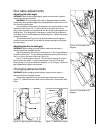
5
This sander should be grounded in accordance
with the National Electrical Code and local codes
and ordinances. This work should be done by a
qualified electrician. The sander should be
grounded to protect the user from electrical shock.
WARNING: Do not connect the sander to a
240 volt power source. The sander motor requires
120 volts alternating current.
General electrical cautions
AWG (American wire gauge) number
Conductor length 240 volt lines 120 volt lines
0-50 feet NOT APPLICABLE No. 14
50-100 feet NOT APPLICABLE No. 12
Over 100 feet NOT APPLICABLE No.8
Wire sizes
Caution: For circuits which are far away from the
electrical service box, the wire size must be in-
creased in order to deliver ample voltage to the motor.
To minimize power losses and to prevent motor
overheating and burnout, the use of wire sizes for
branch circuits or electrical extension cords accord-
ing to the following table is recommended.
Safety instructions for the 1-Inch belt / 8-Inch disc sander
WARNING: Do not operate your machine until it is
completely assembled and installed according to the
instructions.
WARNING: The dust generated by certain woods
and wood products can be injurious to your health.
Always operate machinery in well ventilated areas and
provide for proper dust removal. Use wood dust
collection systems whenever possible.
WARNING: This machine can be use for pro-
cessing wood or metal products. However, combining
wood dust and metal filings can create a fire hazard.
Make sure that the dust collector is free of wood dust
deposits before processing metal products.
1. If you are not thoroughly familiar with the opera-
tion of belt and disc sanders, obtain advice from
your supervisor, instructor or other qualified
person.
2. If there is a tendency for the machine to tip over
or move during operation such as when sanding
long or heavy boards, the machine must be
securely fastened to a supporting surface.
3. Make sure the sanding belt is running in the
proper direction. The sanding belt must travel
downward when viewed from the front of the
machine.
4. Make sure the sanding belt is tracking correctly
in order that it does not run off the pulleys.
5. Make sure the sanding belt or disc is not torn or
loose.
6. Hold the work firmly when sanding.
7. Always hold the work firmly on the table when
sanding on the belt or disc. The only exception is
curved work performed on the top wheel of the
belt.
8. Always sand on the downward side of the disc
when using the disc portion of the machine, so
that the work is held securely on the table.
Sanding on the upward side of the disc could
cause the workpiece to fly up which could be
hazardous.
9. Always maintain a minimum clearance of 1/16-
inch or less between the table and the sanding
belt or disc.
10. Never wear gloves or hold the work with a rag
when sanding.
11. Sand with the grain of the wood.
12. Do not sand pieces of material that are too small
to be safely supported.
13. Avoid awkward hand positions where a sudden
slip could cause a hand to move into the sanding
belt or disc.
14. When sanding a large workpiece, provide
additional support at table height.
15. Never force the work. Slowing or stalling the
motor will cause overheating.
16. When sanding metal, never use a steady stream
of water on the work piece. Dip the workpiece in
water to cool it.
18. All visitors should be kept at a safe distance from
the work area. Make workshop completely safe
by using padlocks, master switches, or by
removing starter keys.
19. Know the tool you are using its application,
limitations, and potential hazards.


















